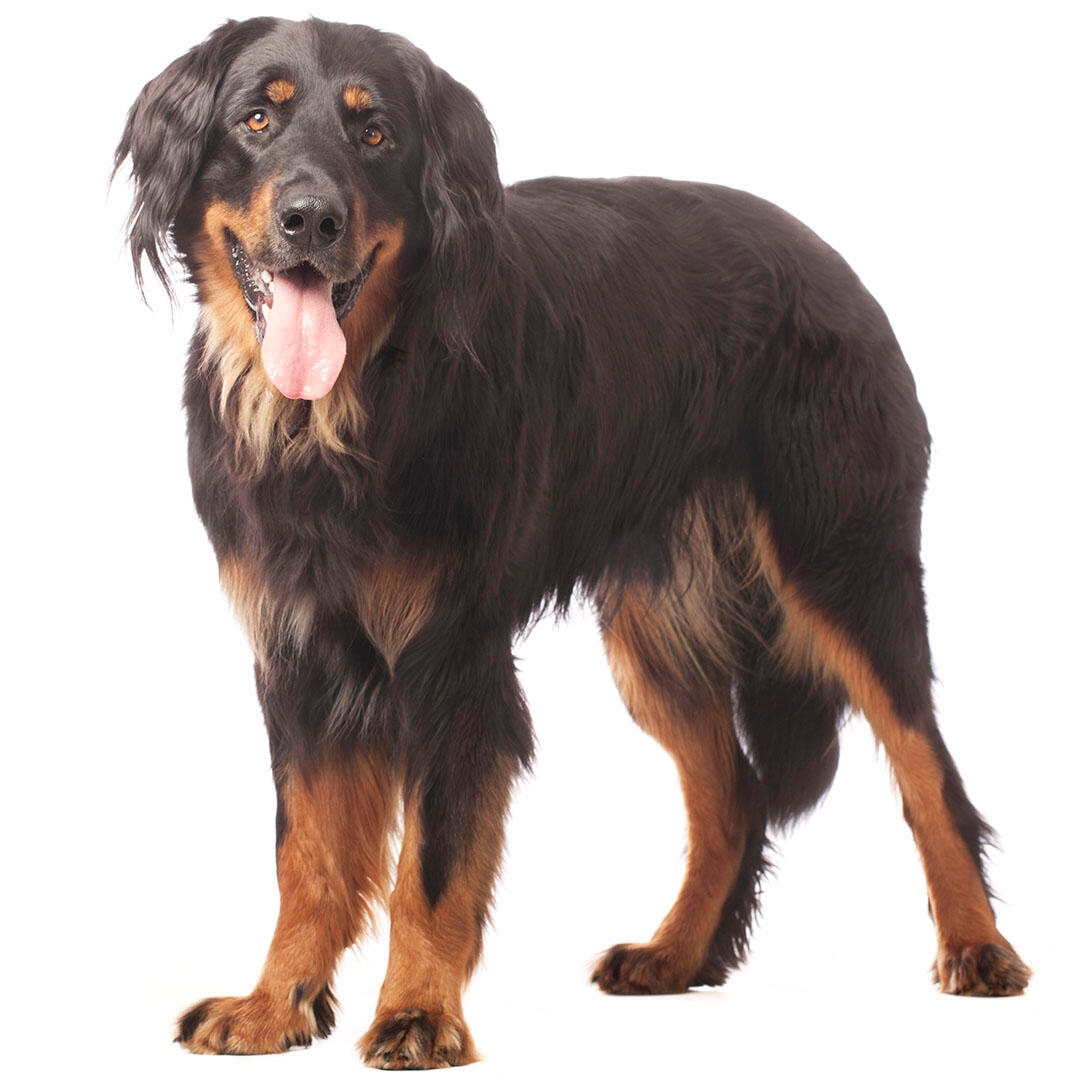
| Family-friendly: | 4/5 |
| Exercise needs: | 4/5 |
| Easy to train: | 2/5 |
| Tolerates being alone: | 2/5 |
| Likes other pets: | 2/5 |
| Energy level: | 4/5 |
| Grooming needs: | 3/5 |
| Shedding: | 3/5 |
The Hovawart breed can suffer from:
- Hip dysplasia
- Hypothyroidism¹ where the thyroid gland is underactive and does not product enough thyroid hormone. This can result in low energy levels, weight gain and skin problems.
- Sebaceous adenitis² which is a disease affecting the skin glands and causing dry skin and hair loss.
- Intestinal adenocarcinoma³ which is a type of cancer which arises from cells in the gut.
Priority Kennel Club health schemes and testing:
- Hip dysplasia screening scheme
¹M. Bianchi et al, 'A multi-breed genome-wide association analysis for canine hypothyroidism identifies a shared major risk locus on CFA12', Aug 2015, PLOS Journal
²J. Lortz et al, 'A multicentre placebo‐controlled clinical trial on the efficacy of oral ciclosporin A in the treatment of canine idiopathic sebaceous adenitis in comparison with conventional topical treatment', Nov 2010, Veterinary Dermatology
³L. Frgelecová, 'Canine gastrointestinal tract tumours: a retrospective study of 74 cases', 2014, Acta Veterinaria Brno
Confident and brave, the Hovawart is a versatile dog and a loyal, devoted companion deeply bonded to their owners. They have strong guarding tendencies and will be protective of home and family, so careful socialisation and training must be provided to ensure they don’t make any errors of judgement with visitors. With that training and socialisation however, they are typically an even tempered and tolerant breed, and easily capable of taking part in a variety of dog sports or activities.
| Family-friendly: | 4/5 |
| Exercise needs: | 4/5 |
| Easy to train: | 2/5 |
| Tolerates being alone: | 2/5 |
| Likes other pets: | 2/5 |
| Energy level: | 4/5 |
| Grooming needs: | 3/5 |
| Shedding: | 3/5 |
The earliest references to the Hovawart date back to 1220, as a dog bred to guard estates, livestock and even castles. Their name derives from ‘hof’ meaning farm or estate and ‘wart’ meaning to guard or watch. The modern Hovawart however is a relatively recently recreated breed, owing their existence to zoologist Dr Konig who set out to reproduce the breed after their demise following WWI. To achieve this, he found similar looking dogs in the Harz and Black Forest areas of Germany where the original type had come from, and crossed them with German Shepherd, Hungarian Kuvasz, Newfoundland, Leonberger and other similar types until he had a breed that bred true, and matched the old drawings of Hovawarts.
The Hovawart suits the rural dweller who has an interest in almost any of the dog sports or activities. They can turn a paw to most things but will thrive with an owner who really enjoys training and walking. Some grooming is required and they will bring mud and wet into the house, as well as drool!
The Hovawart is an active dog who needs two or more hours of dog exercise, with time dedicated to training, games and puzzle solving on top. The Hovawart will enjoy long walks, varied routes and scent-based games such as tracking.
The Hovawart is a big dog with a medium to long coat and so you’ll need space for a wet and muddy dog to dry off, space to groom and to train at home. Ideally suited for the larger country or rural suburban home but not well suited to small town or city life. A big and well fenced garden is important.
Large breed dogs, such as the Hovawart, have large appetites and benefit from a different balance of nutrients including minerals and vitamins compared to smaller-breed dogs. Discover more about how to offer your dog a balanced diet with our easy-to-follow guide.
The Hovawart dog breed comes with an undercoat that is sparse and a top coat that is moderately long and thick. The hair is thicker on the chest, tummy, backs of the legs and on the tail. The coat needs grooming two or three times a week to keep it tangle-free. Find out more about dog grooming and daily care with our article.
Capable of a high level of dog training once mature, the juvenile Hovawart can be a bit of a clown and inclined to ignore owners if not sufficiently motivated. They must be given time to mature but handled sensitively, trained using positive reinforcement and with kindness and consistency, they are capable of competing at high levels of obedience and working trials, or a variety of other dog sports, particularly tracking, man-trailing and Rally.
The Hovawart is a dog better for adult only families or those with teenagers interested in training and working a large dog. Due to their guarding tendencies, homes with very young children or children’s friends coming and going are likely to run into problems.
While many dogs are traditionally thought of as being good with children, all dogs and children need to be taught to get on with each other and be safe together. Even so, dogs and young children should never be left alone together and adults should supervise all interactions between them.
Hovawarts are mentioned in the Sachsenspeigel - a medieval law book written between 1220 and 1235. It was used in some places until as late as 1900 and formed the basis of German law. It is also the first comprehensive law book not written in Latin. Hovawarts were so highly regarded that according to their listing in the Sachsenspeigel “any killed or stolen were to be replaced or paid restitution for”.